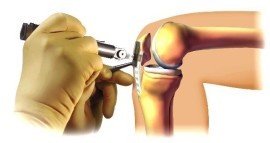About the Operation
The operation
The "keyhole surgery" operation to reconstruct the ACL involves replacing it with other strong tendons from areas around the knee. Two main grafts are in common use: the Hamstring Tendon graft and the Patella Tendon graft. Both are considered to be equally good and the choice usually depends on the surgeon's preference.
Surgery is performed under general anaesthesia and usually takes 1-1 1/2 hours, with the main part of the procedure performed via keyhole surgery (arthroscopy).

The hamstring graft is made from the semi-tendonosis and gracilis tendons, which are cord like structures behind the inner aspect of the knee. These two tendons are usually taken through a small incision on the front of the tibia and are folded in to make a four, five or six stranded structure.

The patella tendon graft is made from the central strip of the patella tendon that runs from the knee cap (patella) to the tibia; a small piece of bone is kept attached to the ligament at each end. Bone graft from the tibia is inserted at the end of the operation into the kneecap to restore contour and to help with kneeling.
The aims of surgery
The aim of the operation is to prevent repeated episodes of giving way or buckling of the knee. Published research shows that approximately 80-90% of patients consider their knee to function normally, or nearly normally, after surgery.
Full contact sport is allowed after rehabilitation but not everyone gets back to his or her previous level. Return to sport depends on the time period since injury and other personal or work factors. Not everyone achieves a full excellent result.
It is important to emphasize that the new ligament is not a 'normal' ligament. Re-creating stability with the graft is only one aspect of attempting to improve knee function after injury. Other problems such as joint surface damage or meniscal tears may co-exist which can interfere with the joint’s ability to tolerate high loads associated with sport and other arduous activities. Also, the wear-and-tear arthritis associated with ligament injury is not necessarily prevented by reconstruction surgery, and the risk of developing osteo-arthritis of the knee in later life is higher once the ligament has been torn.
Potential problems
Problems can occur. Some are minor, but some may need another operation to help. It is clearly important to understand these risks before undergoing surgery.
The main risks include:
- Failure to provide enough stability in the knee to allow return to full sporting activities. Either the ligament does not heal in a tight enough position to allow full confidence in the leg, or there is associated damage inside the knee that prevents return to full function.
- Patella pain or discomfort in the front of the knee joint during activities such as squatting or sitting with the knee bent can develop in 10 - 20% of patients, but this usually improves with specific rehabilitation. More importantly, it can be prevented by appropriate early rehabilitation and by closely following the guidelines and advice given.
- Complications of deep vein thrombosis and wound infection can occur as in all operations. The risk is approximately 1 - 2%. Deep infection in or around the joint may require readmission and washouts of the joint in addition to antibiotic treatment.
- Re-rupture of the graft, which occurs in approximately 5 - 8% of operations over 5 years. This is similar to the risk of rupturing the ligament in the other knee
Early 'normal' concerns following surgery
You may have a series of very normal concerns after surgery. The following is a list of common events that can occur:
Swelling: Swelling or “effusion” in the knee is usual until up to three months after surgery. The main aim of the first phase of rehabilitation is to reduceswelling.
- Difficulty kneeling: After any operation on the front part of the knee it takes a while to tolerate kneeling, but with gradual progression through use of a cushion then carpet and finally a hard floor, this usually improves.
- Bruising: It is usual for bruising to appear down the leg as far as the inner aspect of the heel. It can be surprisingly tender and may take four to six weeks todisappear.
- Numbness around the knee: Numbness around the scars on the front part of the knee is common as the nerves that supply sensation to the skin crisscross around the front of the knee. This can be quite disconcerting for a few months and some residual area of reduced sensation may persist in the long term. Usually this does not affect the function of the leg.
